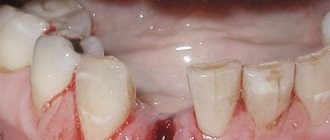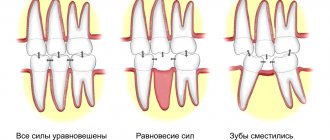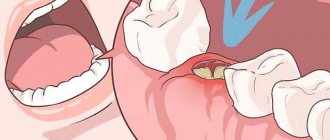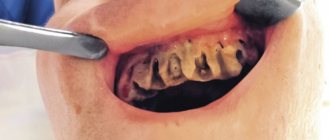Natural processes
Even if the tooth extraction was “simple”, pain in the socket at the site of the extracted tooth is a natural consequence that will bother you for 3-4 days.
This is normal and nothing to worry about, but if the pain causes you severe discomfort, consult your doctor and he will recommend that you take painkillers.
Sometimes regular cold compresses applied to the cheek in the area of the extracted tooth will help relieve pain. This could be a cloth soaked in cold water or ice from the freezer wrapped in a cloth.
Tooth socket
In the case of “complex removal”, in which the gums were cut and sutured, special tools were used to gouge out the root, the pain after the procedure will be felt much longer (the doctor will definitely warn you about this), but will still gradually go away on its own.
If the pain does not go away for more than ten days, consult your doctor: there may be complications in the tooth extraction and you will need dental intervention to eliminate them.
Rules of conduct after tooth extraction
How to care for the hole after extraction? Strict adherence to the dentist’s recommendations will reduce the intensity of pain and speed up the regeneration of damaged tissue.
The following rules should be followed:
- Avoid excessive physical activity in the first 2-3 days after the intervention. It is advisable to give preference to passive rest.
- Avoid eating for 2-3 hours after surgery. Consumption of foods and drinks provokes blood clot disorders. If food gets into the hole, this may cause increased discomfort.
- Try to transfer the load to the healthy side of the jaw.
- In the postoperative period, stop smoking and drinking alcoholic beverages. Alcohol increases pain and provokes an increase in the inflammatory process.
- Do not touch the socket with toothpicks or other foreign objects. A blood clot is very important for successful wound regeneration and its protection from pathogenic flora. It is better to remove food particles that have fallen into the hole by rinsing.
- Treat the oral cavity with antiseptic solutions from the 3rd day of surgery.
- Take painkillers if unpleasant symptoms intensify.
The dentist recommends that you stop rinsing your mouth immediately after the extraction. After 2-3 days you can use:
- Chlorhexidine;
- Miramistin;
- Furacilin;
- A weak solution of potassium permanganate.
Intensive rinsing is unacceptable, as it can cause the destruction of the protective clot. It is better to perform baths: the patient needs to take water into his mouth and hold it near the affected area for 1-3 minutes. After this, the solution is spat out. The treatment regimen is supported by diet.
In the first few days after tooth extraction, patients are advised to eat liquid, warm foods. You should avoid consuming sweet foods, soda, and alcohol. Drinks must not be drunk through a straw.
Alveolitis
Very often, after the removal of any tooth, the patient develops alveolitis - the tissues in the socket of the extracted tooth become inflamed due to the fact that a protective blood clot has not formed there (or was washed out during brushing or rinsing the teeth).
The main symptom of alveolitis is significant pain in the area around the socket of the extracted tooth. At the same time, the gums swell, the temperature rises and general malaise is observed.
Alveolitis can be cured only by relieving inflammation, for which special anti-inflammatory drugs are prescribed, and sometimes physiotherapy.
You should not try to cure alveolitis yourself based on the recommendations of friends (“I’ve already had this happen”) or information from the Internet (“the best dentists recommend”). Such treatment can lead to more serious consequences, in the worst case - even osteomyelitis: inflammation of the bone tissue of the jaw.
Healing of the socket with gum inflammation
If tooth extraction was carried out against the background of inflammation, or the inflammatory process in the gums developed later, epithelization of the wound begins on the 10th -14th day, bone beams appear only by the 15th day. A significant part of the socket is filled with young osteoid tissue only by the end of the second month.
After a complex tooth extraction, when the gums rupture and the walls of the socket are traumatized, the edges of the gums cannot come together for a long time and the epithelization process slows down. Wound healing can only be completed after 1-1.5 months. In this case, the development of new bone tissue is delayed.
Socket bleeding
Socket bleeding most often appears immediately after surgery, although sometimes several days pass between tooth extraction and the onset of bleeding.
Bleeding from the socket of an extracted tooth can occur for several reasons:
- The patient actively disturbs the socket of the extracted tooth - he feels it with his tongue or hands, inaccurately brushes his teeth or aggressively treats the sore spot with an irrigator;
- Physical damage in the socket area - gum injury, fracture of the alveoli, and so on;
- Concomitant diseases of the patient: hypertension, leukemia, etc.
Treatment for alveolar bleeding depends on the cause and source of bleeding.
Healing of the hole
If the gums bleed in the area of the socket, then the problem may be complications after surgery, and the wound will need to be stitched.
If blood comes from the vessels directly in the walls of the socket of the extracted tooth, then it is first cooled, after which the vessels are compressed and a tampon with a hemostatic agent is placed in the socket for 4-5 days.
If local remedies do not give the desired effect, the dentist prescribes the patient to take general hemostatic agents.
Normal and pathological signs
What should the wound look like after extraction? It is necessary to consider which symptoms are normal and which are pathological. Normally, on day 3, the wound is covered with a white film, which signals the healing process. By 4-5 days the entire hole becomes light. If a coating of any other color forms on the surface of the wound, and an unpleasant odor emanates from the mouth, you should immediately consult a doctor. The sign indicates that an infectious process has begun.
Photo of the hole after removal
A normal reaction of the body after extraction is inflammation and swelling of the gums. The signs are due to the fact that during the intervention, damage to soft tissues, blood vessels and nerve endings occurs. Pain after surgery is also normal, but only if it lasts no more than 5-7 days. After removal of sixes, sevens or wisdom teeth, an unpleasant sign radiates to the ears and joints. In the latter case, it becomes difficult for a person to chew. All of these symptoms are normal and usually do not get worse over time. Dentists recommend taking painkillers for 5 days to avoid discomfort.
Bruise on the cheek after tooth extraction
Pathological signs of socket healing after tooth extraction:
- increased pain;
- pulsating nature of pain;
- temperature increase;
- inflammation of the lymph nodes;
- aching sensations in the area of neighboring elements, manifesting itself for more than 2-3 hours;
- rise in temperature;
- signs of intoxication of the body;
- the hole does not overgrow.
An alarming sign after the intervention is the appearance of severe swelling of the cheeks and gums in the first few hours. To reduce the intensity of the symptom, you can apply a cold compress to the problematic side. If the inflammation intensifies or spreads to the chin and neck, you should immediately consult a doctor or call an ambulance. The symptom indicates the rapid progression of an infectious complication.
Photo of a swollen cheek after tooth extraction in the socket
A physiologically normal symptom after tooth extraction is bleeding for several hours. The intensity of bleeding varies for several hours after the intervention. Heavy discharge is observed within 15-30 minutes, after this time the symptom should appear less intensely. The bleeding stops completely after 2 hours.
If the bleeding does not stop, then it is necessary to apply a gauze swab moistened with an antiseptic solution to the damaged area. A doctor is consulted when the performed manipulations do not produce results. An additional symptom that is a reason to consult a doctor is a temperature above 38 degrees.
How to avoid problems?
First of all, after tooth extraction, you must carefully follow your dentist’s recommendations for the rehabilitation period.
After the operation, the doctor will apply a cotton swab with a hemostatic solution to the wound for 30-40 minutes. You must remove it from the well after the designated time has passed very carefully so as not to damage the clot.
After tooth extraction, you should not eat any food for two hours so that its fragments do not fall into the fresh wound.
For several days, you should not disturb the socket of the extracted tooth - neither with your tongue, nor especially with your hands.
If, after the period indicated by the doctor, the pain in the socket does not go away, moreover, it intensifies, and at the same time there is redness and swelling of the gums, pus from the socket, fever and general malaise - be sure to consult a doctor.
There is no need to hope to fix the problem at home; self-medication will only make it worse for yourself.
How to speed up the healing of a hole
To speed up the healing of the hole after tooth extraction, you need to follow these rules:
- Do not touch the blood clot on the socket with your tongue, much less with your hands or a toothpick, so as not to damage it. The presence of a clot is a guarantee of speedy healing of the wound.
- For three hours after visiting the dentist, you should not eat or rinse your mouth. Compliance with this point will also help maintain the integrity of the blood clot.
- · Drinks and food should not be too hot or cold for several days after removal. The food chosen is soft, without coarse inclusions, to prevent injury to the gums.
- You should not engage in heavy physical work for several days to avoid opening the wound and resuming bleeding.
- Since tobacco smoke and alcohol irritate the mucous membrane and inhibit the healing of the hole, you need to stop smoking and drinking alcohol for a while.
- To prevent infection from entering the wound and reduce inflammation after a traumatic tooth extraction, antiseptic baths are used. For them, solutions of chlorhexidine or furatsilin, infusions of sage, chamomile, and eucalyptus are used. The solutions are taken into the mouth, held for several minutes and carefully spat out.
- On the third day after removal, you can carry out antiseptic rinses with the same agents.
- Taking anti-inflammatory drugs (nimesulide, ibuprofen) will help not only eliminate pain, but also relieve the inflammatory process, which also helps accelerate socket regeneration.
- If the doctor has prescribed antibiotics, you should not refuse them, since eliminating the microbial infection shortens the healing time.
- When brushing your teeth, be careful not to touch the wound with the brush.
- To speed up healing, you can use Solcoseryl dental paste. It enhances intracellular energy exchange, due to which cell regeneration and restoration of damaged tissues are accelerated. Solcoseryl also creates conditions for the growth of granulation tissue. The paste is applied to a previously dried surface, then moistened with water. Before using the medicine, it would be more correct to ask your dentist about when to start using Solcoseryl after tooth extraction and how many times a day to apply it to the gums.
Content
- Mandatory radiography
- Possible consequences after removal
PROMOTION
Dental restoration, installation of fillings
from 2200 rub.
Tooth extraction is a frequently performed operation, the results of which may require additional research. Tooth extraction is prescribed if there are compelling reasons. It is not advisable to carry out manipulations in the acute stage. It is better to carry it out as planned while there is no pain.
An X-ray is recommended to be taken only if the problem that has arisen cannot be resolved by external examination - for example, which tooth is affected, if the pain is reflected in several places at once, or what is the structure of the wisdom tooth.
Only a specialist can decipher the image, knowing the meaning of the black and white tones of varying intensities displayed in the image. For example:
- Crowns and fillings will be displayed in white color - unlike natural tooth tissues, they are not translucent;
- The holes between the teeth and the cavities in them will appear black;
- Soft tissue and liquid are reflected in shades of gray.
Such research is not dangerous. Moreover, the patient’s body is covered with a protective apron - X-rays do not cause harm to health.
After the manipulation, the surgeon examines the extracted tooth. If:
- All roots have been removed; a control x-ray is not necessary;
- When a tooth is destroyed during extraction, it is necessary to take a photo;
- In case of complex removal, an x-ray is necessary to ensure that the operation was performed correctly.
If there are no violations:
- The bleeding stops quickly;
- A clot forms in the hole;
- The wound heals quickly.










